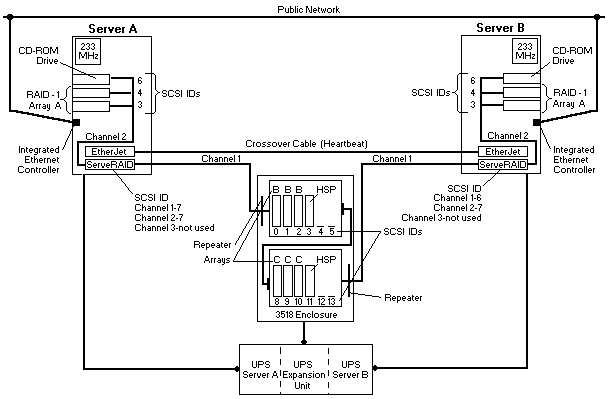
PC Server 325 Tower Cluster Example

The network-crossover cable, sometimes referred to as the cluster's heartbeat, provides the dedicated,
point-to-point communication link between the servers.
This cable connects the IBM 100/10 PCI EtherJet Adapters (one in each server) and enables the servers to continuously monitor each other's functional status.
The servers connect to the public network using the Ethernet controllers on the system boards.
Using the public-network connection and the dedicated heartbeat link together ensures that a single
network-hardware failure will not initiate a failover situation.
Notes:
The only difference between the hardware configuration of Server A and the hardware configuration of
Server B is the SCSI ID settings for the ServeRAID adapters. Channels 1 and 2 of the ServeRAID
adapter in Server A are set to SCSI ID 7. Channel 1 of the ServeRAID adapter in Server B is set to SCSI
ID 6, because it shares the same SCSI bus as Channel 1 of the ServeRAID adapter in Server A. Channel
2 of the ServeRAID adapter in Server B connects to the nonshared drives and is set to SCSI ID 7 to avoid
a conflict with the CD-ROM drive, which is set to SCSI ID 6. On both ServeRAID adapters, Channel 3 is
available for use as a quorum-arbitration link with the Microsoft Cluster Server software, or for future
expansion with the Vinca clustering software.
In addition to the standard features of the PC Server 3518, the expansion enclosure contains a
power-supply upgrade option, an additional backplane, two enhanced SCSI repeaters, and cables. The
maximum achievable hot-swap storage capacity 3 for this enclosure is 163.8 GB using eighteen 9.1 GB
drives. However, this example shows only eight drives, which leaves space for future expansion.
To help maintain high availability, the eight hard disk drives are defined as two RAID level-5 logical drives
(arrays B and C). To further increase the availability of these shared drives, each ServeRAID adapter has
its own hot-spare (HSP) drive. A hot-spare drive is a disk drive that is defined for automatic use in the
event of a drive failure. If a physical drive fails and it is part of a RAID level-1 or RAID level-5 logical
drive, the ServeRAID adapter will automatically start to rebuild the data on the hot-spare drive.
Note: ServeRAID adapters cannot share hot-spare drives. To maintain high availability and enable the
automatic-rebuild feature, you must define a hot-spare drive for each ServeRAID adapter.
The jumpers on the backplane in Bank D are set for Bank D and for high addressing (SCSI IDs 8, 9, 10,
11, 12, and 13). A cable connects the Bank C and Bank D backplanes, creating one continuous SCSI
bus.
Channel 1 of the ServeRAID adapter in Server A connects to the enhanced SCSI repeater that connects
to Bank C, and Channel 1 of the ServeRAID adapter in Server B connects to the enhanced SCSI repeater
that connects to Bank D. The enhanced SCSI repeaters contain circuits that can automatically sense the
functional status of the server. When the SCSI repeater circuitry detects that the server attached to it is
failing or offline, the SCSI repeater automatically enables termination for that end of the SCSI bus. This
helps increase the availability of the shared disks and enables the serviceability of the failing or offline
server.
Ideally, the servers and storage enclosures are connected to different electrical circuits, however, this is
rarely possible. To help prevent the loss of data and to maintain the availability of the shared disks during
a power outage or power fluctuation, always connect the servers and expansion enclosures to
uninterruptible power supplies (UPS).
Please see the LEGAL - Trademark notice.
Feel free - send a  for any BUG on this page found - Thank you.
for any BUG on this page found - Thank you.